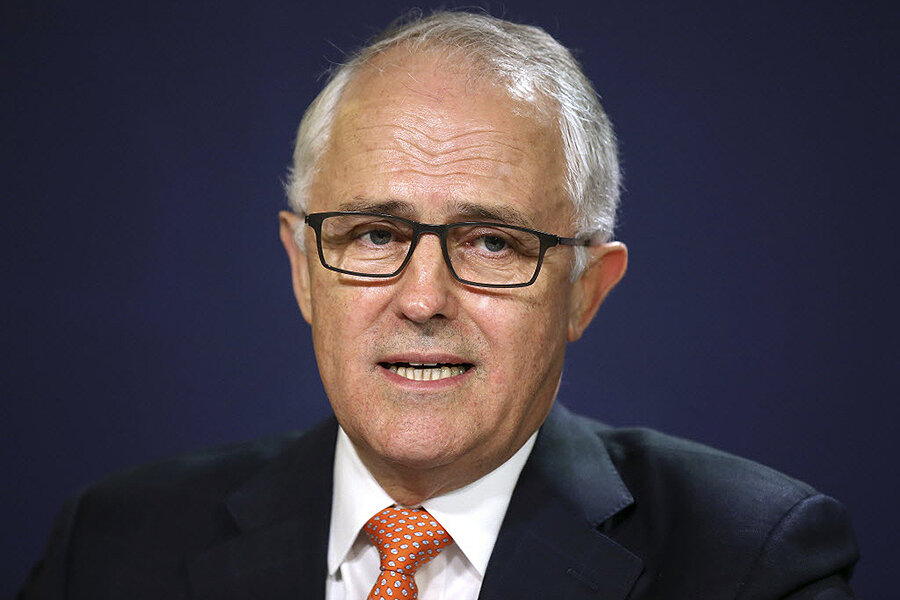Juvenile detention videos a shock to Australian consciences
Loading...
A leaked video depicting harsh treatment of a teenager housed in a youth detention center in Australia’s Northern Territory has prompted prime minister Malcolm Turnbull to announce the formation of a royal commission to investigate the facility.
"Like all Australians, I have been deeply shocked, shocked and appalled by the images of mistreatment of children" at the Don Dale detention center in Darwin, said Mr. Turnbull on Australian radio on Tuesday morning.
The CCTV footage was aired by ABC Four Corners, an Australian investigative news program, and spans a five-year period dating back to 2010. In one scene, teenager Dylan Voller – who appears in the clips from ages thirteen through seventeen – is seen gripped by the neck, slammed onto a mattress and stripped. In others, he is struck by guards, hogtied, bound to a chair and hooded in order to keep him from spitting at guards.
Dylan and several other children who appear on the program are suing the Northern Territory for mistreatment, according to the Guardian. Such treatment “may amount to torture by the government responsible for their care,” UNICEF says.
"This is a shocking state of affairs and we will move quickly to establish what happened," said Turnbull. "We need to move quickly on [an inquiry], get to the bottom of it and expose what occurred and expose the culture that allowed it to occur and allowed it to remain unrevealed for so long." The inquiry may be expanded beyond the Don Dale center, which was shuttered amid the tear-gassing allegations in 2014, to encompass facilities across the Northern Territory, he said.
Allegations of abuse in juvenile detention centers located in the poor and sparsely populated Northern Territory, where Aboriginals account for a much higher portion of the population than the national average, have made headlines in the past. But the video has elicited an usually fervent public reaction – in part, some suggest, because Dylan is white.
"People have known for a long time that the Northern Territory has quite draconian law-and-order policies," said Rhonda L. Evans, director of the Center for Australia and New Zealand Studies at University of Texas-Austin, in an interview with The Christian Science Monitor. "I have to wonder if it's getting traction partly because the image is of a non-indigenous youth."
The sense that problems can go ignored in the Northern Territory, however, extends beyond its Aboriginal communities.
"Because the Territory's a long way from anywhere, there's a culture of 'we'll ignore it, it will go away, the rest of the country's attention will turn somewhere else and we'll get on with what we always do'," ABC's Kate Wild, who has spent years reporting on the issue, wrote in an op-ed.
"While people in the Northern Territory have been aware of these stories and these incidents in Don Dale for a long time, seeing the pictures of them last night on Four Corners I know has rocked some people absolutely to the core."
In one report authored by the Territory’s children’s commission, which delves into a August 2014 incident at the Don Dale facility, guards were said to have used tear gas against children as young as 14, restrained and “spit hooded” residents, and deprived them of drinking water for long periods. The account of tear-gassing is borne out by the ABC footage.
About one-third of the Northern Territory’s inhabitants are Aboriginal, a relatively high percentage, and one that rises in the most remote areas, according to the Australian government, compared with 5 percent or less in all other parts of Australia. But 86 percent of prisoners in the territory are Aboriginal.
And the Territory's passage of harsh mandatory sentencing laws in the 1990s triggered growth in prisoners' numbers, putting the territory's imprisonment rate far above that of other Australian territories, with a disproportionate impact on indigenous communities.
The ranks of juvenile detainees, meanwhile, are no different: the correction services department reports that 94 percent of detainees were indigenous in 2014-2015. And as The Diplomat notes, the region’s rate of youth detention is the country’s highest, at five times the national average.
"A lot of people don't care about law-and-order issues when indigenous people bear the brunt of it," says Dr. Evans. "It will be interesting to see how the issue gets framed" by lawmakers, she says: as a question of youth detention alone, or one with significance for the rights of Aboriginals, as well.








